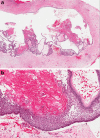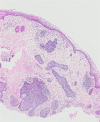New tumour entities in the 4th edition of the World Health Organization Classification of Head and Neck tumours: odontogenic and maxillofacial bone tumours
- PMID: 28674741
- PMCID: PMC5886999
- DOI: 10.1007/s00428-017-2182-3
New tumour entities in the 4th edition of the World Health Organization Classification of Head and Neck tumours: odontogenic and maxillofacial bone tumours
Abstract
The latest (4th) edition of the World Health Organization Classification of Head and Neck tumours has recently been published with a number of significant changes across all tumour sites. In particular, there has been a major attempt to simplify classifications and to use defining criteria which can be used globally in all situations, avoiding wherever possible the use of complex molecular techniques which may not be affordable or widely available. This review summarises the changes in Chapter 8: Odontogenic and maxillofacial bone lesions. The most significant change is the re-introduction of the classification of the odontogenic cysts, restoring this books status as the only text which classifies and defines the full range of lesions of the odontogenic tissues. The consensus group considered carefully the terminology of lesions and were concerned to ensure that the names used properly reflected the best evidence regarding the true nature of specific entities. For this reason, this new edition restores the odontogenic keratocyst and calcifying odontogenic cyst to the classification of odontogenic cysts and rejects the previous terminology (keratocystic odontogenic tumour and calcifying cystic odontogenic tumour) which were intended to suggest that they are true neoplasms. New entities which have been introduced include the sclerosing odontogenic carcinoma and primordial odontogenic tumour. In addition, some previously poorly defined lesions have been removed, including the ameloblastic fibrodentinoma, ameloblastic fibro-odontoma, which are probably developing odontomas, and the odontoameloblastoma, which is not regarded as an entity. Finally, the terminology "cemento" has been restored to cemento-ossifying fibroma and cemento-osseous dysplasias, to properly reflect that they are of odontogenic origin and are found in the tooth-bearing areas of the jaws.
Keywords: Fibro-osseous lesions; Maxillofacial pathology; Odontogenic cysts; Odontogenic tumours; WHO classification.
Conflict of interest statement
Funding
The authors have not been funded for this work.
Conflict of interest
The authors declare that they have no conflict of interest.
Figures





References
-
- Pindborg J, Kramer I. WHO International Histological Classification of Tumours. Histological typing of odontogenic tumours, jaw cysts and allied lesions. Geneva: WHO; 1971.
-
- Kramer I, Pindborg J, Shear M. WHO International Histological Classification of Tumours. Histological typing of odontogenic tumours. 2. Berlin: Springer-Verlag; 1992.
-
- Barnes L, Eveson JW, Reichart P, Sidransky D. Odontogenic Tumours. Ch 6, WHO classification of tumors: pathology and genetics of head and neck tumours. Lyon: IARC; 2005.
-
- El-Naggar AK, Chan JKC, Grandis JR, Takata T, Slootweg PJ (2017) WHO Classification of Head and Neck Tumours, 4th edition). Chapter 8. 204–260 edn. IARC, Lyon
-
- Shear M, Speight P (2007) Cysts of the oral and maxillofacial regions. 4th ed. Blackwell Munksgaard
Publication types
MeSH terms
LinkOut - more resources
Full Text Sources
Other Literature Sources
Medical

